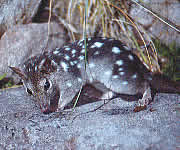Each month we bring you scenes and description
from western Arnhem Land or other parts of the Top End - showing
the country, bush food, and other aspects of Aboriginal life. On
this page you can visit:
The main photographs and text are by Wayne Miles, an outstanding
photographer from Darwin.
| July and August are the time of the cool dry season
in the Top End. The nights can be chilly but days are mild with
clear blue skies. Most of the plants and grasses have dried out,
and the creeks have slowed to a trickle or diminished to still
pools. The dry season is a time when many of the mammals breed,
including the gliders, northern brush tail possum and the northen
quoll, the largest of the native carnivores in the Top End. |
 Northern Quoll
Northern Quoll |
July - In the Paperbark Swamps
During the height of the rainmaking season, the paperbark swamps
of the Cobourg Peninsula in Gurig National Park are totally submerged
in floodwaters. By July-August, in the season also known as "Angurduyirruk",
cloudless blue skies reign and the waters slowly contract to the deeper
parts of the swamps and billabongs. These black, cool waters now become
sanctuaries where the last of the water lilies flower, where the long
necked turtles fatten and burrow deep into the soft black mud in preparation
for the drier months ahead, and where the crocodiles and barramundi
that have not retreated to the tidal sections of the great rivers
are now trapped.

Flying fox superimposed on image of
Paperbark Swamp on Cobourg
Easy pickings for the Aboriginal spears and turtle sticks
that will soon seek their prey. Paper bark (Melaleuca) swamps provide
ideal living and breeding conditions for a diverse range of fauna.
Many could not survive elsewhere. Vital links in this ecosystem are
the flying fox (pictured above) and the larger black flying fox, both
of which compete at this time of year for the rich, nectar bearing
blossoms, high in the paper bark tops. Their squabbling signals to
the Aboriginal hunters that the fox's fat reserves are now reaching
their peak. In this condition they are one of the most prized food
sources in all the north.
August - Hunting for Crocodile and Turtle Eggs
On the Mary River flood plain, a cool monsoonal forest stands in complete
contrast to the hot dry bushland that surrounds it. A crystal clear
spring-fed creek bubbles its way through a tall shaded, forested refuge,
which at this time is home to wallabies, fresh water turtles, crocodiles,
fish, reptiles and birds of prey. August is a time of much stillness,
of cloudless blue skies. The bush growth appears to stagnate as if all
is dried. The finding of water is now the most important task of all
living things. To the Aboriginal people, permanent fresh water systems
such as this sustain wildlife through August to October, the driest
months, and harbour an abundance of edible bush fruits.

Digging freshwater crocodile eggs, monsoon
forest at Point Stuart near Darwin
At this time, the blossoming of the small Turkey Bush signals that
fresh water crocodiles are laying their eggs in the sandy banks of permanent
waters and that long necked turtles have reached their peak in fat reserves.
For those who understand the signs, the harvest and hunt for this prized
bush tucker can now begin.
| Having collected bamboo lengths from a clump on a
nearby river bank, Geoffrey Campion of Arnhem Land sits cross legged
straightening the shafts over a fire, preparing them as spears to
hunt fresh water crocodiles, turtles and fish. Spikes or prongs
are then bound onto the shafts using strong bush string. This is
then sealed in native bees wax that is collected from the base of
tall Stringybark
(Eucalyptus) trees. When this Stringybark flowers it signals the
sweet nectar "sugar-bag" (native honey) is ready for harvest |

Straightening bamboo for spears |
Text and photographs copyright Wayne Miles 1999
Back
to Seasonal calendar entry page
|